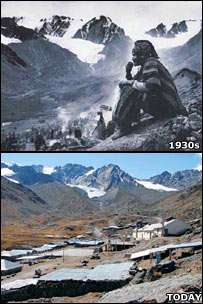 Located in the Andes Mountains of South America, the Quelccaya Ice Cap is the largest tropical body of ice in the world. According to recent research, one of the glaciers in this ice cap, the Peruvian Qori Kalis (pictured), is rapidly melting and could soon vanish completely, providing the clearest evidence yet for global warming.
Located in the Andes Mountains of South America, the Quelccaya Ice Cap is the largest tropical body of ice in the world. According to recent research, one of the glaciers in this ice cap, the Peruvian Qori Kalis (pictured), is rapidly melting and could soon vanish completely, providing the clearest evidence yet for global warming.
"I would not be surprised to see half of it disappear in this coming year," said climatologist Lonnie Thompson, from Ohio State University, at the Advancement of Science's (AAAS) annual meeting in San Francisco.
Thompson has been studying the Qori Kalis glacier since 1978.
"In the first 10 years [that] we observed the glacier, it was retreating 6 meters (19.7 feet) every year," Thompson said. "In the last few years, it has started retreating 60 meters (197 feet) every year - a 10-fold increase. On top of that you will have natural phenomena like El Nino, which release heat into the lower atmosphere," he predicted.
The same rapid retreat seen in Peruvian glaciers is also occurring around the world.
"The combination of those two things will have a big impact on glaciers throughout the tropics," said Thompson. "No matter what we do, we are going to lose the glaciers on Kilimanjaro and the lower elevation glaciers in the Andes."
"Kilimanjaro could be gone by 2020," he suggested. "In the Andes, some of the glaciers are bigger, but I think we are talking 30 to 50 years."
This will cause many problems for some of the poorest people on earth since they depend upon annual glacial melt to sustain their crops. Loss of these glaciers will cause a huge drought and crop failure.
"These changes are going to take place and these people will be impacted," observed Thompson. "They have to find ways to adapt."
Cited story.
.

Thanks for the post. Very timely for me. I am currently working on a paper for my 2nd year glacier geology class. I am looking at the declining mass of tropical glaciers and the consequences with an emphasis on the Cordilla Blanca Mountains region in Peru.
In addition to the agricultural problems I am also researching the loss of electricity generated by hydro plants along glacially fed rivers.
If anyone has any suggestions as to where I could find more information regarding agriculture practices and hydro plants in the area I would grateful. I can't read Spanish.
Thanks
David
David .... This ones for you :
http://www.google.com/language_tools?hl=en
Todays WaPo on Antarctica
http://www.washingtonpost.com/wp-dyn/content/article/2007/02/17/AR20070…
thank you admin